#facial expression analysis
Explore tagged Tumblr posts
Text
He Said, She Said, Lies, Lies, Lies
w
Can a machine truly know when we are lying? In a world where artificial intelligence permeates every aspect of our lives, from the phones in our pockets to the cars we drive, the idea that AI can now discern the truthfulness of our statements may sound like science fiction. Yet, here we are, on the cusp of an era where AI doesn’t just work for us; it understands us – perhaps even better than we…
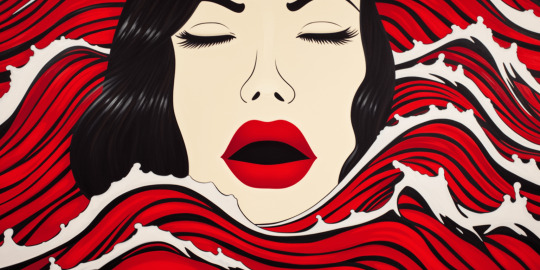
View On WordPress
#AI in communication#behavioral cues#facial expression analysis#human behavior interpretation#Lie detection#lip-reading AI#speech analysis#truthfulness#ventriloquism#voice processing
0 notes
Text
Robots with Emotions: How AI is Advancing Emotional Intelligence
Robots with Emotions: How AI is Advancing Emotional Intelligence Emotional intelligence (EI) is a vital aspect of human interactions, facilitating empathy, understanding, and communication. Recent advances in artificial intelligence (AI) have enabled the development of robots with the ability to understand and display emotions. This report explores the significance of emotional intelligence in…

View On WordPress
#AI#Applications#Artificial Intelligence#Body Language Interpretation#Consent#Customer Service#education#Emotional Dependency#Emotional Intelligence#Emotional Manipulation#Emotional Recognition#Emotions#Ethical Considerations#Facial Expression Analysis#Future#Healthcare#Human-Robot Interactions#Privacy#Robots#Social Impact#Society#Technology#Voice Sentiment Analysis
0 notes
Text
Starting another in the sword series!
#i like figures without faces because you have to react to them on a more base level#instinctive and emotional#not an intellectual analysis of facial expression#and you have to find the story from pose and gesture alone#which opens them to interpretation and hearing how other people interpret what i make is like. my favorite thing.#his eyeline isn't quite on the sword#it's above it. looking at the one who wielded it#or at what comes after.
800 notes
·
View notes
Text

Slow-motion Loop Charles Mask Up moment
so we can all overanalyze the micro-expressions on both Crystal and Charles' faces here in their conversation and relationship
#crystal palace#crystal palace surname von hoverkraft#crystal x charles#charles x crystal#gif#gifs#my gif#my gifs#text post#cryland#rowlace#jayden revri#kassius nelson#charles rowland#dbda#dead boy detectives#dead boy detective agency#the case of the lighthouse leapers#character dynamics#character relationships#character analysis#face journey#facial expressions#scene analysis#dbda meta#fave#save#reference
137 notes
·
View notes
Text
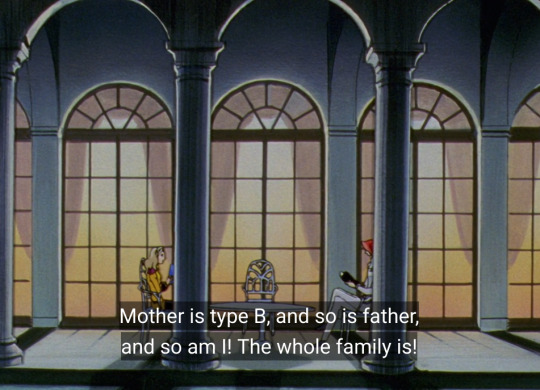

Word of God/movie backstory aside, it suddenly came to me that there is one other gap of knowledge that has probably contributed to a significant part of the alienation between Touga and Nanami, and it's something that existed throughout all of Nanami's life, so it's given that she wouldn't truly notice it: Touga knows they're adopted, Nanami does not. I think that makes a big difference.

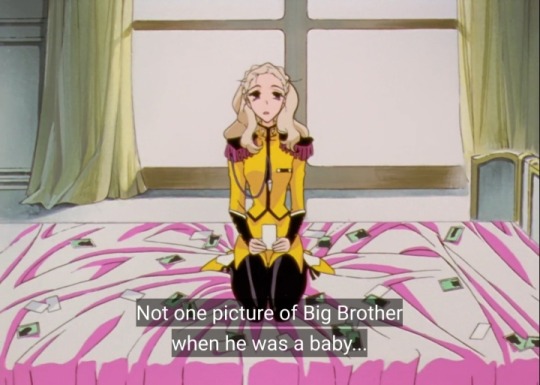
Touga's backstory is bound not to be the exact same as the movie (After all, Nanami isn't even there with him), so I'll let myself speculate a bit. Their biological parents could have died, they could have abandoned them or sold them, or the siblings could have been removed from their care, and unless Nanami was brought in later to wherever Touga was, it's safe to assume that he spent at least 5 years with his original parents. He has memories of a different family, and of losing that family. Nanami doesn't even know about any of it. She doesn't realize there is a side of her brother that she never got to meet.


"Blood" is very important to Nanami. Blood is what Nanami uses to try and reassure herself that the parents who are cold and distant to her, and the brother who's grown cold and distant too, have an eternal unbreakable bond. It's very brittle though. Nanami constantly fears being replaced, discarded or harmed by her family. Most often by Touga, who ironically, happens to be her only blood relative there.
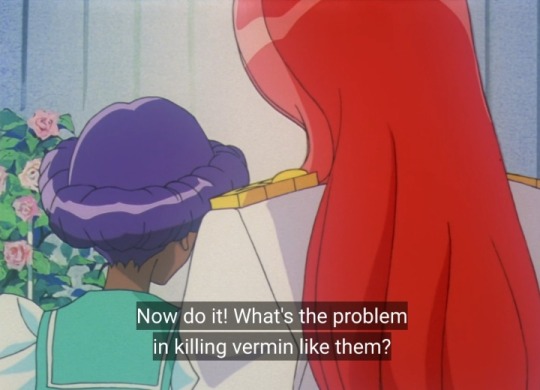
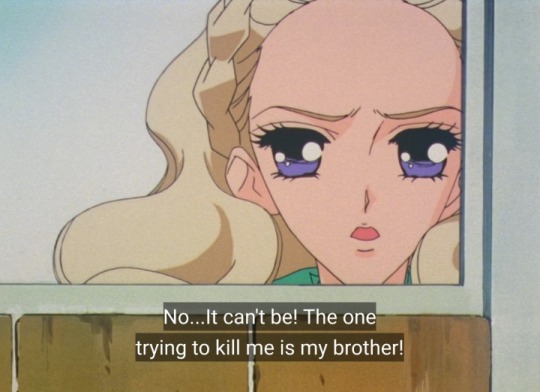
Her anxiety can be very easily explained by her experiences with how she was treated growing up in the Kiryuu household, but I do wonder if there's some subconscious parts of her that tap into these knowledge gaps too. I already felt like it was there, in the way her love for her brother is as protective as it is possessive, and how to protect him from harm, be it real or perceived, she can go feral, often shooting wildly at whoever she thinks is to blame, always hitting the wrong targets; and so maybe, I thought, it is possible that her anxieties are also tied to these repressed early childhood memories. Ones of once having a family, and then losing that world, being thrown someplace unfamiliar. Vague mostly forgotten memories fueling her fear of abandonment, working like a constant little nagging at the back of her head signaling to her how little blood ties really matter in the end.
"Blood" doesn't matter to Touga in the same way. He doesn't hold into a rose colored view of it. He knows by experience how easily those ties can be severed, how fickle they are. That's why when he found a little girl in a coffin, a little girl who spoke of there not being anything eternal, of how those you care about are bound to leave you, and questioning what's even the point of living then, he couldn't give her anything. He couldn't save her. He didn't know the answer for himself either.
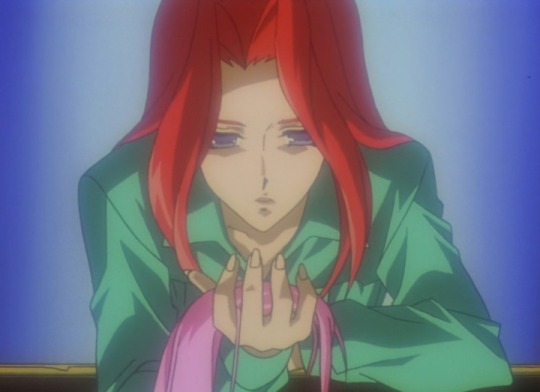
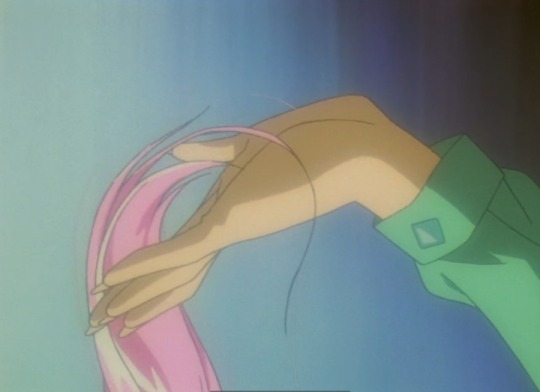
#revolutionary girl utena#shoujo kakumei utena#sku#rgu#utena meta#touga kiryuu#nanami kiryuu#utena tenjou#ambi utena post#utena analysis#I'd asked for help with the IDs in the tags but since no one responded I've finally done it myself#fuck that was so difficult#I had to google so many damn words#english being my secong language makes this hard and so does me being autistic#I struggle to describe feelings and facial expressions#meowga kittyuu#<– my tag for the cat
246 notes
·
View notes
Text
Evolution of Homestuck’s Art Style, Pages 1-1550

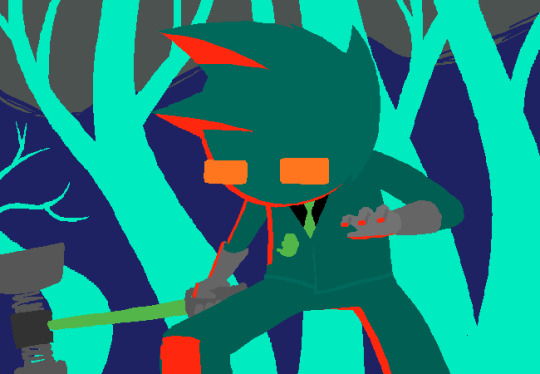
[page 1, 1434]
Since Act 4 began, I’ve been blown away by the visual difference between this and the earlier comic – there’s been a big shift in style, and huge increase in the use of color. So, re-reading and just looking at the art style, here’s an overview of the changes so far.
[a short one – 2.8k words below the cut + some very beautiful panels. I was limited to 30 images in a post, so would recommend looking up page references for the ones tumblr wouldn't let me include <3]

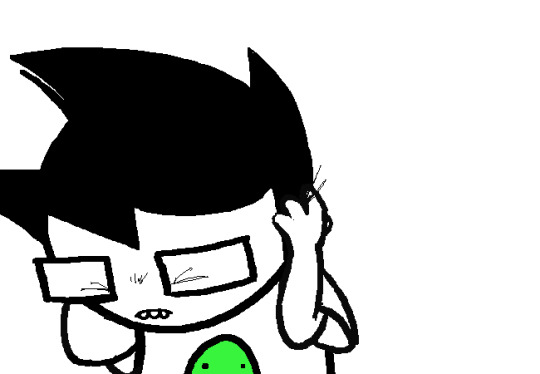
[page 4, 16]
Act 1 mostly uses sprite art and clean, tidy images; the white background is the dominant color in most panels. Where John is drawn freehand, he’s drawn as close to his sprite as possible, with a thick black outline and blocky shapes. This is often done to give him a more complex pose or facial expression than a sprite would allow (for example, p.16). John’s house is relatively tidy, filled with discrete items that it’s easy to move around and manipulate to create new panels – these are mostly either imported photographs rendered in black and white, or line drawings similar to John’s sprite. Occasional items are drawn in color – some due to their importance (Sburb logos) but some due more to common sense (blood capsules).
John’s captchalogue and strife systems are colored overlays on panels that are still mostly black and white. Full color panels show up when John (or Rose) uses a computer, showing their desktop background, or when John looks or goes outside and observes his neighborhood. Here, his near monochrome, thick-lined sprite stands out against the lineless background (the car and mailbox help soften this for now).

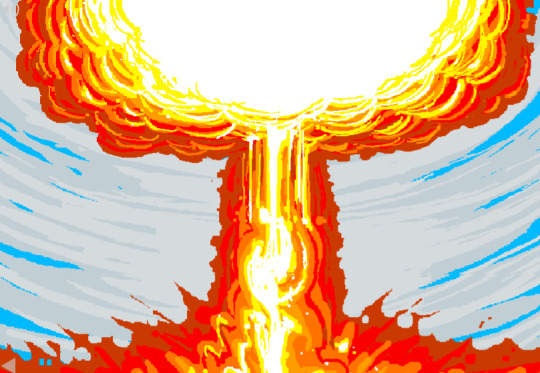
[page 195, 246]
Over the next few acts, Homestuck will develop an art style typified by its lack of outlines and straights, abundance of curves and swirls, use of patterned blocks of solid color to create light and depth effects, and emphasis on motion. Act 1 has the earliest steps towards this – my favorite is page 195, where John looks through his telescope and sees the meteor heading towards him. These styles of sky, clouds, wind, and small animated elements that don’t dominate the panel are all still common techniques in Act 4. The final shot of the meteor cloud in the End of Act 1 flash animation (p.246) – which is almost entirely full color outdoors shots – is another great example.
Act 1 is definitely not dull or colorless, and there's a real charm to its style, but it is overall functional. Panels are designed to give information, show the results of commands, and communicate a change of state from the previous panel – it’s unlikely someone would look at them just for aesthetic value. Act 1 has the closest to an ‘adventure game’ look, as lots of John’s items look like they should be clicked on for more information, and rooms are often rendered in an isometric style. In a narrative comic, this also makes John feel boxed in and stifled by the imposing walls and lack of color. His world is stark, monotonous, and cut-and-paste, somewhere he has been placed instead of somewhere he naturally belongs.


[page 312, 363]
Act 2 stays primarily monochrome, but panels are busier on average. Dave’s room (p.312) has so much going on in comparison to John’s (p.4) that in a video game, it’d be hard to know what to click on first. John’s room has become much busier now that it’s been looted and smeared by imps, which makes it harder to keep the art consistent between different panels and angles. Like John and Rose, Dave’s computer, house exterior, and inventory systems are shown in color. Dave’s living room is monochrome but has a fair amount of color through his brothers’ puppets, while John’s now has imps in harlequin outfits, build grist, and Nannasprite.
Rose is unique among the kids for never being placed on a white background. When she’s first introduced, her room is shown in pale gray to indicate that it’s getting dark in her house. This color is unobtrusive, close to white, and doesn’t feel like it makes the panels more complex. As a wildfire creeps closer, the sky around Rose tints red – a slight burgundy on page 398, and a more dangerous wine red on page 985. The mausoleum is also gray, with a soft lineless background unlike other indoor spaces. Rose is the first beta kid to leave her house entirely and go to a secondary location, heading down to the Skaianet Laboratory on page 840 – a much more visually complex area in which she’s shown against a green background until she goes back to the fire. If there’s any examples of her in a white space, I missed them!
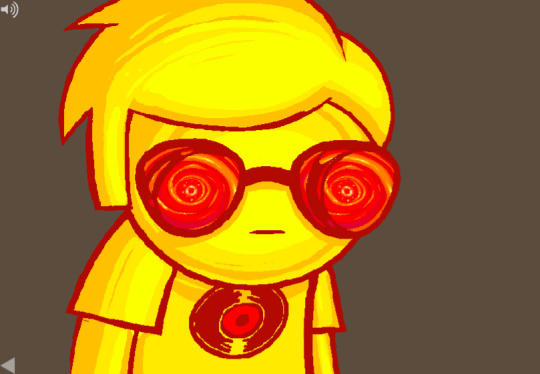

[page 444, 665]
The kids are still drawn close to their sprite style, with occasional variation. Dave’s sprite is shaded in red and yellow on page 444 to represent the ‘sick heat’ he’s trapped in, and he’s shown in red silhouette as he steps onto the roof on page 665. In ‘WV: Ascend’ (p.757), every frame is full color and more detailed than most previous panels, and the kids’ and guardians’ sprites stand out as the only cut and pasted element. The landscapes are changing faster than the characters, which creates a feeling of unfamiliarity and their struggle to keep up with their new circumstances.

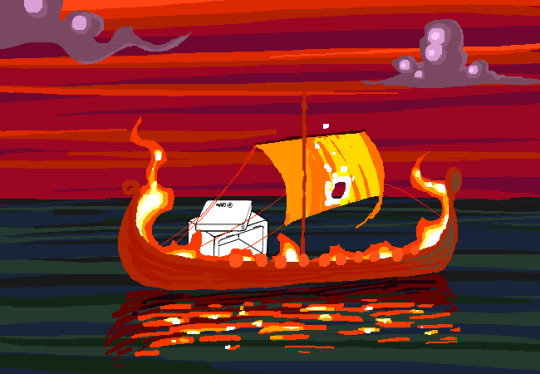
[page 248, 558]
The Wayward Vagabond’s panels immediately look different from the kids’. Page 248 is easily the most complex still image up to that point, with the greatest color diversity (four shades in the sky, one in the city, and I think as many as eight in the sand). It’s very different from the blocky blue sky at John’s house. WV has a sprite too, but his is full color, meaning that when he’s drawn freehand he’s drawn without an outline. This makes him feel ‘part’ of the background instead of pasted on top of it, merged with his landscape while the kids are at odds with theirs. The 100-page Wayward Vagabond point of view section is the first extended sequence of full color panels, but by this point they’ve shown up enough that it doesn’t feel jarring.
Act 2 has the first panel where the art itself blows me away. Page 558, with its fiery boat sailing into the sunset, goes harder than any panel that’s come before it entirely in service of the Vaulthalla pun.


[page 760, 840]
Act 3 introduces Jade in the typical sprite style and monochrome interior, but she appears in her windowed garden atrium, so at least half of her first panel is in full color. The exterior of her house is more colorful and prominent than any kid before her, with various colors of clouds and plants; the same is true of her computer, which surrounds her in three-dimensional spinning colors instead of being a two-dimensional screen. Jade’s room is the biggest and messiest yet, as in just two acts the comic is already feeling limited by its ‘character stuck in a room’ format.
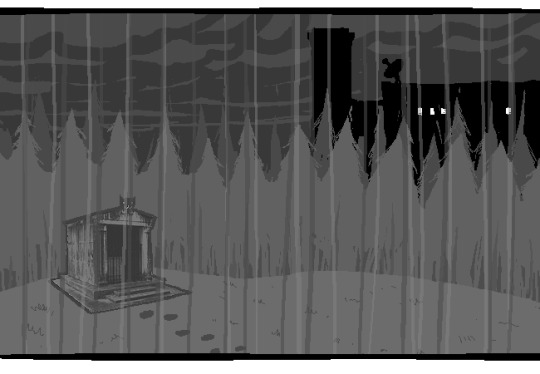
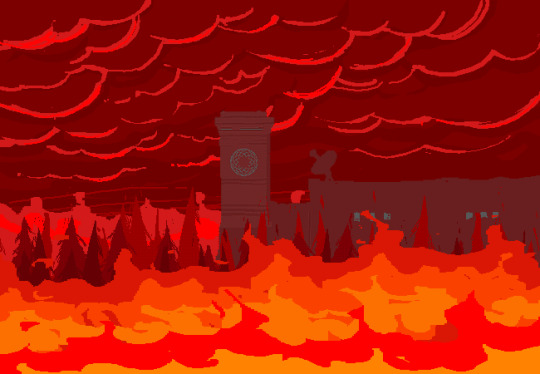
[page 225, 986]
This act shows the art style in transition, with even more color and complexity introduced into what are technically indoor panels of the kids, and more excuses found to draw in the softer, lineless style. On page 840, the tunnel Rose walks through is sketched like a sky, when an act earlier it might have been made of simpler, blockier shapes. Page 986 shows a very similar view to page 225, and the new version isn't necessarily more complex but it is more Homestuck, with increased texture and definition in the clouds and a fire moving through layered lines of color.
Just like in Act 2, ‘Years in the future…’ pages lead the charge with the changing art style. Pages 924, 1005 and 1035 provide lush post-apocalyptic landscapes with a beauty that isn’t seen on present-day Earth – even Jade’s island on page 1080, clearly designed to be visually interesting, doesn’t have quite the liveliness and definition of the post-apocalyptic pages (in my opinion).


[page 1051, 1147]
Act 3 also introduces the aesthetic vertical page. Previously, vertical pages are used occasionally for their aspect ratio, showing a book or the entirety of John’s house. Page 1051’s art isn’t giving information or showing a changed state, but stands out as an impressive visual and a pause for breath in between panels that do give information. Page 1147 is similar, and I believe it’s also the first time a beta kid is drawn in the lineless style (with detail to their form, not just a silhouette). This page comes right before the end of act flash, showing the final form the art has now achieved.
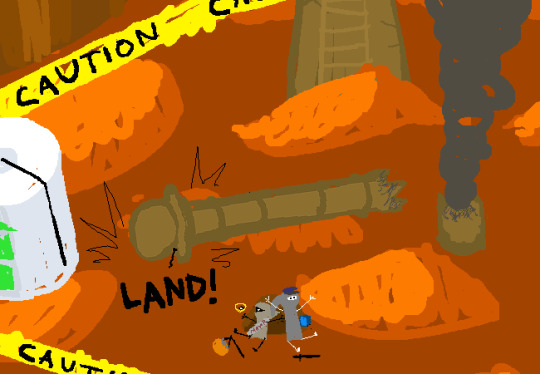

[page
Besides the monochrome sprite art associated with the kids’ houses and the lineless style associated with the outdoors, Act 3 introduces a couple more styles. One is the scribble style, first introduced with WV’s Can Town fantasies and murals, and then scattered throughout Jade and the exiles’ scenes in Act 3. Some panels in this style are explicitly intended to be drawn or imagined by an in-universe character, while other times they represent a strong emotion or sudden interruption.
The other new style is the color-adjusted jpeg, seen in Prospit (p.1029) and the dark kingdom (p.886), where the background is composed of externally-sourced images that have been manipulated and recolored. The over-saturation of a single color makes the location recognizable without need for its own distinctive art style – Prospit is entirely gold or yellow, the dark kingdom is entirely purple, and the Felt’s mansion is entirely green.
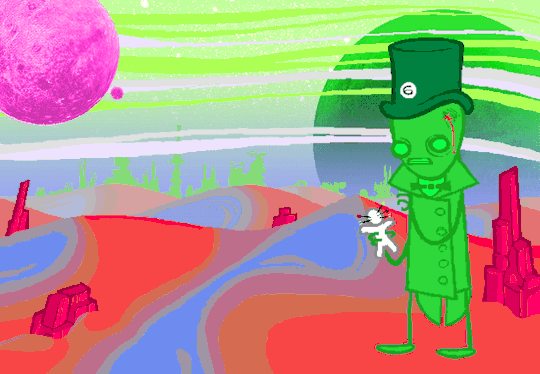

[page 1236, 1337]
The Intermission is made almost exclusively in this style, which adds a lot of detail to backgrounds while sacrificing some distinctiveness. While sprite art is used, the sprites themselves are entirely black or green, so they complement their environment the same way John complements his Act 1 house. By using images of a mansion’s interior as panel backgrounds, the Intermission is arguably more ‘realistic-looking’ than the representational art and medieval castles of the Acts, which ties into its grittier and more grounded tone.
With its goal of a fast production pace in advance of a more complex Act 4, there aren’t many artistic standout pages in the Intermission. A rare exception are the pre-city wasteland panels, such as page 1236, which blend the jpeg technique (for the stars and planets) with a lineless alien landscape of pleasantly rolling dunes. Pages 1188 and 1337 also blend these styles, but this is the extent of the lineless panels until Slick enters the safe.
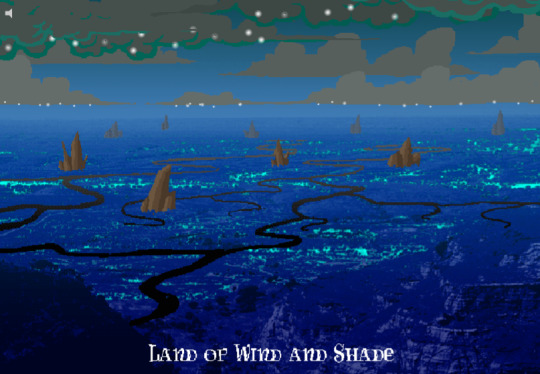
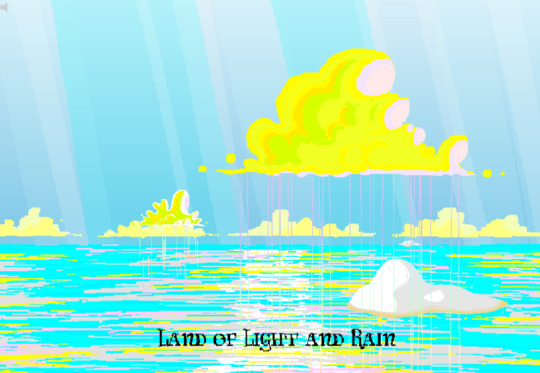
[page 1358, 1407]
Act 4 introduces the Land of Wind and Shade (LOWAS) and the Land of Light and Rain (LOLAR), two planets with distinct designs in the lineless style where John and Rose’s scenes now exclusively take place. Both are stunning – LOWAS is mostly dark blue with gray clouds, and a focus on bioluminescence through its mushrooms and fireflies, while LOLAR is mostly white landmasses amid a sea of pastel blue, pink and yellow. Since Act 1, Homestuck has taken care to set its animated pages primarily outside the kids’ houses, with the notable exception of page 253’s walkaround. This is likely because color makes flash pages more interesting to watch and easier to interpret – but character or plot developments have still been the focus. Page 1407, which introduces LOLAR, is the first flash with a primarily aesthetic function.
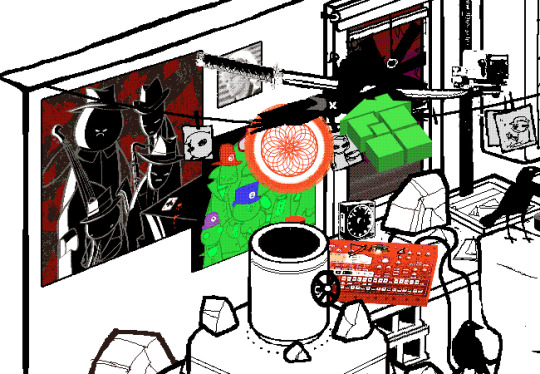

[page 1446, 1457]
In Act 4, panels that might have been standouts in previous acts are now commonplace, such as John answering messages on page 1391-2. Use of brown and yellow keeps the exiles’ pages visually distinct from John and Rose’s, but they’re no longer a clear upgrade. This helps the comic skip back and forth between John, Rose and the exiles without a narrative transition, as the art change is less jarring. Pages that take place in Dave’s monochrome room are now the outliers, while Rose and John’s sprites (and Dad’s car) really feel like relics of previous acts. Even with John’s new full-color suit and Rose’s land including a lot of white, their stark lines and lack of shading don’t merge well with their landscapes and always become the focal point when these sprites are used.
As such, there’s more examples of John and Rose in a lineless style, which feels long overdue and catches them up with changes that have already happened. Fully lineless panels tend to be very well composed with clear artistic intent; easy to interpret and pleasing to look at. They often represent movement even when not animated, so work well for transitioning to or away from a character. Sprite panels, on the other hand, have much lazier composition. Messes don’t get cleaned up, and panels show irrelevant objects often half-inside the panel and half-outside, so even when they’re communicating clearly they’re often less pleasant to look at – I find this true of AR’s introduction in Act 3 (p.1100-1111) and all the Dave and Jade scenes in Act 4. Page 1446, for example, features the first prototyping of Dave’s sprite, but it’s hard to focus on the crow-sword’s move through the room with so much else in the way (in contrast with page 185, where the harlequin doll is clearly in focus for its prototyping).


[page 39, 1523]
As a final comparison to illustrate this change, let’s look at page 39 side by side with page 1523. In both cases, a character is typing in Pesterchum. The reader has already seen the kid’s location and nearby possessions, so the images do nothing more than illustrate that the character is on their computer, while the meat of the page is in the Pesterlog.
On page 39, this is situated between two John panels where he takes different actions (assigns Hammerkind and captchalogues a book), so page 39’s image feels necessary to the sequence. On page 1523, this is immediately followed up by another image of Rose, still on her computer, and one that feels far more dynamic. Rose gets a facial expression and sitting position that give her some character, the close-up shot feels intimate for an important conversation, and the background is still present through the ocean behind Rose and the shading from her umbrella. So while there’s nothing wrong with page 1523 (which does successfully re-establish Rose after some pages away from her) or with the sprite style in general, the upgrades to other areas of the art do make the sprite pages feel weaker by comparison.
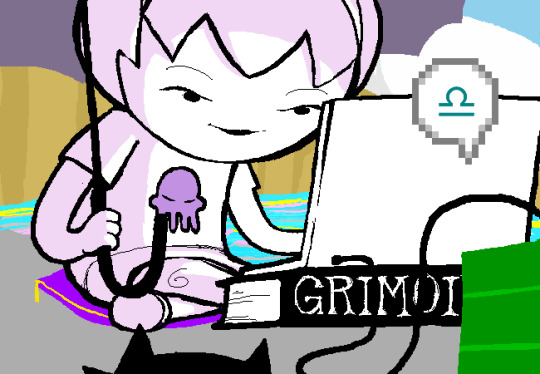
[page 1524]
Whether intended or otherwise, the kids’ houses being the only monochrome, heavily outlined spaces while all other locations are full color and mostly lineless, is really evocative of the comic’s title. The first full-color panel is John’s desktop on page 24 featuring the Slimer background he made himself, and later his computer becomes a gateway to the Medium where he can access a whole world of color designed just for him. In contrast to being ‘stuck’ in defined dimensions and copied images, the kids are entering a world of beauty, motion and art for its own sake. The exiles’ panels introducing the lineless style and the kids’ following reflects the exiles guiding the kids into the Medium and towards their eventual quests. LOWAS and LOLAR’s fantastical designs add a sense of magic to the story, bringing it away from games and technology and towards more esoteric, unknowable forces. Their unique designs compared to the kids’ similar-styled houses recalls Rose and gallowsCalibrator’s mentions of Sburb’s ‘flexible mythological framework’ (p.440) or ‘HYP3R FL3XIBL3 MYTHOLOGY’ (p.1524), which apparently extends to the level of art style.
Personally, I think the swirling, lineless art style Homestuck has developed is very pretty, but does take away the ‘point and click game’ feeling of Act 1. It’s interesting that the art style develops alongside the reader-command format – Act 1 is almost entirely reader commands, while Acts 2 and 3 mix reader commands with author-driven exile commands and ==> pages, and Act 4 has already seen the reader suggestion boxes close for good. I think the question of ‘is Homestuck a game?’ is still relevant, but needs a different answer in Act 4 compared to Act 1. The level design of LOWAS, LOLAR, Prospit and the dark kingdom is excellent, but they’re for running around and fighting, not standing still and clicking. The genre has changed, and the characters’ roles in the game are being reconfigured alongside the players’ and narrators’ roles.
So, how will Homestuck’s art develop from here? My guess is that there will be a decrease in GIFs and an increase in still images, as the new style is likely harder to animate and better at conveying motion without animation. Act 4 is setting up to bring Dave and Jade into the Medium as quickly as possible, at which point there will be five planets (including post-apocalyptic Earth) each with their own distinctive designs. Once this happens, there will be no need for scenes inside the kids’ houses, and the comic will be able to eliminate the kids’ sprites altogether (or at least re-design them with more color and fewer stark lines, more similar to the trolls’, exiles’ or Felt members’ sprites). Dave and Jade’s sprites being prototyped may further affect the Medium, perhaps affecting the light and dark kingdoms as planets as well as just their agents. Finally, I think there will be a focus on how the kids’ actions physically change the landscape of their planets, as this has already been the case with their modifications to their houses.
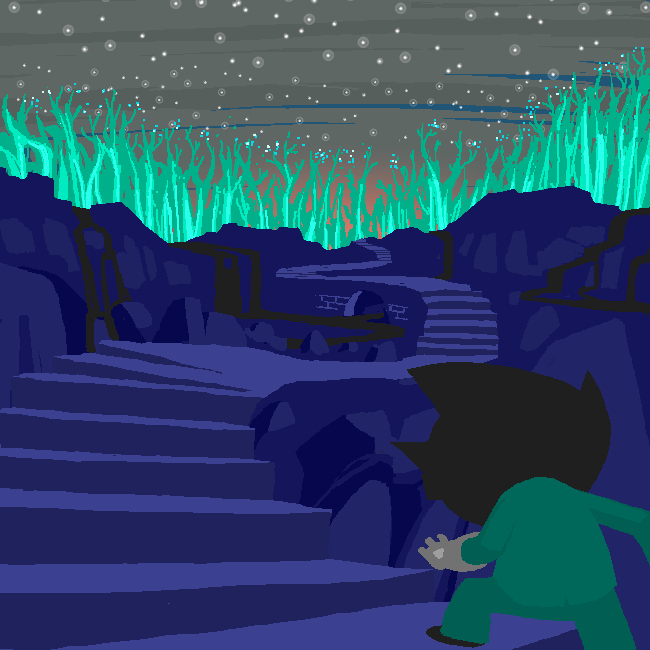
[page 1395]
#homestuck#analysis#i like to look at it! it's a beautiful comic there's a whole bunch of panels id get framed for my wall#if i had money or a house!#act 3 also doesn't have a super defined identity so thinking abt it as a transitional act for the art is cool to me#also wish id thought a lil more abt facial expressions and emotions and how they are represented in sprites#but im trying to keep posts short and simple and not let them get away from me. so. i will stop here <3#chrono
22 notes
·
View notes
Text
JayVik is like... big anxious excitable dog with overflowing emotions x tiny bitchy more reserved cat who you better not cross
#viktor is a bitch and i love him so much#jayvik#thoughts#I read a meta/analysis last night where someone was like when we see them after the time skip#it's like a dog that was trying to hold its own leash#and I was like oh my God you're a genius that's EXACTLY it#viktor has a huge heart and is deeply kind too bit he's also#crucially#a huge bitch#arcane#i simply think Viktor communicates mostly with facial expressions and not so subtly hitting ppl with his cane/crutch#I also think they are ADHD 4 Autism in a nutshell#arcane meta
20 notes
·
View notes
Text
Losing the idgaf war over here but re: “tsukasa needs to be saved from wxs/rui actually wants to hurt him”

Read it’s on! Wonder halloween

Read it’s on! Wonder halloween!
Rui: ascending to the stage from the seats won’t have enough of an impact. He needs to make a powerful impression as a knight…
Rui: Oh, I’ve got it! That will definitely be better! But I’ll have to assess it’s practicality and safety first.
Read it’s on! Wonder halloween!
Rui: anyways, the stage is sorted and we’re ready to hold our show. I’ll start planning the next one in the meantime.
Rui: hmm… maybe I can make it easier for tsukasa by reusing some of the gimmicks that worked with him last time.
Read it’s on! Wonder halloween!

Read it’s on! Wonder halloween!
Tsukasa: ah, it’s wire-flying time!
Rui: he somersaults in the air and flies past his pursuers…
Emu: that’s going to look INCREDIBLE ♪
Tsukasa: this is just the kind of daring performance I was born for! What comes after that, Rui?
Read it’s on! Wonder halloween!

Read it’s on! Wonder halloween!
Rui: but you have me mistaken, Tsukasa… I… I’m making changes to improve the show…
Tsukasa: and I’m telling you to quit lying like that!
Tsukasa: I told you that I’m going to make the most of the role you’ve given me. I’ll pull off whatever you throw at me, no matter how tricky it might be!
Tsukasa: we have the potential to put on a jaw-dropping show, but you’re holding back!
Read it’s on! Wonder halloween!

Read it’s on! Wonder halloween!
(Asked if he was mad at himself for getting hurt) Tsukasa: Of course! I still am too! I killed the director’s confidence, didn’t I? I’m not a star, I’m a disgrace!
Tsukasa: a real star inspires their director to entrust them with any role! To unleash their imagination and try new ideas!
Read it’s on! Wonder halloween!

Read it’s on! Wonder halloween!

Read it’s on! Wonder halloween!

Read it’s on! Wonder halloween!

READ ITS ON! WONDER HALLOWEEN!!!!!!!!!
#(said with increasingly homicidal intent)#find it really funny that when rui was in his head abt it tsukasa kept being like#dangerous stunt? dangerous stunt? ohh u wanna suggest a dangerous stunt???#it’s like a dog when it knows its owner is sad so it keeps doing tricks hoping the owner will cheer up#mine#rui#tsukasa#i know it seems like I think they’re funny & I make fun of them (because they deserve it)#but make no mistake I also take them seriously. it’s just less entertaining to talk about.#analysis#not really but I’m putting it in the tag in case I need these quotes later#inventing new and exciting ways to get around the image limit every day#watching it would be better you lose the facial expressions and tone if u just read#but I’m making the request as easy as possible here#their freak is mutual and consensual tsukasa signs up for this
23 notes
·
View notes
Text
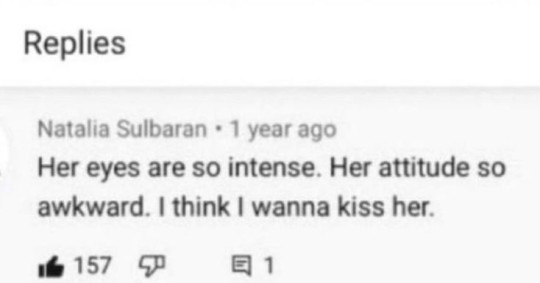
#she's so awkward w everything#i love her#jokes aside she probably has some serious mental issues#i feel like she's even more numb than she was in season 2#great comparison is how she reacted to a gun being pointed at her in season 2 and now in season 3#in s2 there was genuine fear in her facial expression#but now?#nothing#god i just want her to be happy but i'm afraid the chances are high it's not gonna happen#this post was supposed to be silly why am i doing a depressing analysis in the tags#the bad batch#emerie karr
33 notes
·
View notes
Text
Cooper Abbott (Trap, 2024) as a Firefighter | Mini-Analysis
Hi there and welcome back to me analysing the character Cooper Abbott (portrayed by Josh Hartnett) in the movie Trap (written, produced and directed by M. Night Shyamalan)! This one is a mini-analysis and interpretation of a particular aspect of his character, based on one short scene and things we've been told and given glimpses of during the movie: Cooper working as a firefighter. It's also mostly speculation after because I like to think further, of course. I'd be happy to know what others think about this aspect of him, so if this were to spark a conversation, that'd be great! :') <3 And for anyone, who might be interested, here is the more in-depth character analysis of Cooper that I wrote.
As we get to know Cooper Abbott in the beginning of the movie, one particular detail we're told about him is that he's a firefighter.
He tells Jamie, the vendor of the merch stand at the Lady Raven concert, that he works in the fire department, which allows him to garner trust from Jamie, who now sees him as 'one of the good guys' that he can tell details about the concert's function as a trap for Cooper's serial killer persona "the Butcher". Toward the end of the movie, when Dr. Grant - the FBI profiler - explains her psychological profile of Cooper to Rachel, his wife, we catch a glimpse of a photo of Cooper and some of his colleagues at the fire station advertising the firemen calendar. While Cooper talks to Lady Raven in her limousine, he also tells her that the houses he keeps his victims in, and also plans in, are vacant due to fire code violations, suggesting that he uses the resources he's given as a firefighter to help with his murders, like knowing which houses will be empty for longer periods of time. And during Cooper and Rachel's confrontation afterwards, she specifically mentions that the smell of cleaning fluid on him furthered her suspicions of his serial killing, because it's not the kind he would use at the station, but rather what she associates with hospitals.
Those are the things we are told and shown about Cooper when it comes to his work as a firefighter. But there is one scene about halfway through the movie, where we actually witness him working as a first aider.
In an attempt to avoid being seen by Dr. Grant when Cooper is backstage at the concert, he helps a teenage girl, who was about to collapse on the stairs behind the stage. He catches her when she's starting to fall over, lifts her up and carries her, and then asks a staff member where he should put her. Inside the medical tent, he sits her down on a chair and soothingly talks to her, while treating her for her possible low blood sugar and dehydration. He tells her that he'll get her some juice, while putting a cooling pack on the back of her neck, and that she'll feel a lot better within the next half hour. Even one of the medical staff members in the tent was impressed with his work, more or less jokingly asking to keep him because of how good he is with the patients.
This scene shows how natural his work is to him. Cooper is incredibly skilled and quick, just as he is when he's thinking of ways to cause distractions and find a way out of the venue for himself. He's focused and has a great way of making the other person feel safe and like they're in good hands with him with the way he's speaking in a low, soothing voice, and stays on a figurative, and even literal, eye level with them when he does. In short, Cooper seems to be in his element when he's helping the teenager. It also shows very clearly that he's been doing this for many years because of how natural his movements and words are for him.
Having been shown how he would be on the job, essentially, also raises the question why he chose to be a firefighter in the first place.
Personally, I think that he became a firefighter because it's a job that is thrilling and never the same, but with a certain degree of control he has over everything that happens; even if some situations can be rather unpredictable. He still decides the course of action (depending on his position within the department) and, to an extent, what happens to the people he's helping. This job allows him to be close to injury and death without being the initial cause. Whether or not he abuses his power to play around with what humans could potentially survive or not is up to debate. I think it's safe to say, though, that it taught him a lot of useful things for his future murders, while giving him a way to have several safe houses without anybody knowing, and without having to spend any money on them and therefore leaving no traces of his presence. It might have also allowed him to gain access to tools he uses, or at least know where to get them, what he can use, and how, without raising suspicions. This is especially evident when Cooper tells Lady Raven about the lethal effects of carbon monoxide on a person in a small and closed space, stating that "you need to know about these sorts of things as a firefighter", as he explains to her that he'll use it to easily kill Spencer, his current victim, if she refuses to help him out of the venue or signals the FBI. If his only reason to be a firefighter had been power, control, and being close to injury/death and danger, he could have just become a police officer, which could have even allowed him to manipulate what the police knows about his murders. But since he's a firefighter, there are more ways to interpret and speculate why he chose that profession.
On that note, I also want to add that another possible reason for his decision to be a fireman could be his upbringing and the abuse he experienced at the hand of his mother. This could go two ways; although they don't negate one another. One being that he wanted to actually help people out of situations where they are in danger and feel helpless because he never had a helping hand when he needed it most in his youth. Therefore, he would be using it as a kind of coping mechanism for his trauma. The other being that he uses this job to counteract "the monster", as his dark side has been dubbed by his mother and later himself. It is possible that he initially tried to be better and do something useful - something good - to prove his mother, and by extension himself, wrong about his being a monster. Both are potential explanations for his choice that can be true at the same time.
So far, those have been my thoughts about Cooper being a firefighter and why that's the chosen profession for him. Of course, there's also the simple reason that it's one of the best covers for him because people wouldn't immediately suspect a fireman to be a serial killer. But since Cooper has most definitely been a firefighter for much longer than he's been a murderer (presumably, at least), I also think that it's reasonable to consider different explanations for this choice.
#cooper abbott#cooper adams#trap 2024#these kinds of things are on my mind 24/7 since watching Trap for the first time :) only analyses :)#i can't wait to buy the movie so i can also take screenshots of sth i really wanna talk about but can't because-#-it'll only work with photo evidence so to speak because it's about specific facial expressions of his#oh Germany please release Trap digitally ASAP pleasepleaseplease#character analysis#jesse.talks#jesse.analyses
17 notes
·
View notes
Text
see the thing that i hate about live action media is i hate hate hate looking people in the eyes/looking in peoples faces. it FREAKS me out significantly. even over media, even through pictures, even with the filter of screens. I can't do it. so when people are like "omg this characters expression during this scene oh my god!" girl i am going to be sick
9 notes
·
View notes
Text
I don't understand why TLM 2 tried so hard to emphasize and clarify how much Ariel is like her mother in terms of personality when she is, in the movie, quite frankly, written to be more like Eric in character. She was really primarily introverted, shy, awkward, tomboyish, mild-mannered and more serious, which is more like her father. I guess it was her impulsive, curious, rebellious and reckless nature that made the characters in the movie go, "Ow, she is so like her mother!", but I don't know, whenever I see Melody, I see her as closer to her dad. I'm pretty sure I'm not the only one who sees it this way. I don't believe for one second that NO ONE in that universe was able to notice the similarities she had with her father. C'mon, she even has his doggone smile! 😂
#melody#eric#disney#the little mermaid 2#meta#disney meta#character analysis#txt#i've seen a few screencaps of her and i'm like “man that's eric child”#he made that girl damn near like him the only difference is the facial structure nose and eye shape#this was not a mistake from the animators and writers. she makes a lot of similar facial expressions#“like mother like daughter” more like father like daughter!#but that was when she was kid she could have changed later on. some kids do change A LOT when they get older#i feel like the older she got the more she resembled her dad#it seems that way prolly because it was from the perspective of ariel's side of the family/heritage but i mean#i'm pretty sure they spent a lot of time around eric enough to get an idea of what his personality is like#and if you bitches say he had no personality i'm going to strangle you so hard you are gonna see nothing but blackness#tired of that silly ass false ass argument. but ANYWHO#i'm DAMN SURE grimsby noticed the parallels. eric's staff most likely said “she is just like her father”
5 notes
·
View notes
Text

#food for thought#character analysis#contrasts#facial expressions#screengrabs#talisorvikposts#loladapt
0 notes
Text
OKAY BUT WAIT I HAVEN’T HAD A CHANCE TO TALK ABOUT THIS MOVIE YET!!! i think the visual of a bird in a cage and how kenma was literally SCHEMING during the whole game, showing his cunning intellect because he’s getting increasingly invested in the game, his friendship with shoyo, him coming out of his shell, expressing how he truly feels about volleyball— all of it was SO amazing to see unfold. not gonna lie, kenma was for sure giving main character in the film because he was such a pivotal character during this game, he plays an important role in shoyo’s growth as a volleyball player and in how he views himself/his abilities. this is gonna turn into a think piece soon soooo i’m gonna cut it off here but all this to say: this movie was great !!! reminds me how invested i can get into hq and it’s been so long since i’ve watched. i missed these guys a lot <3
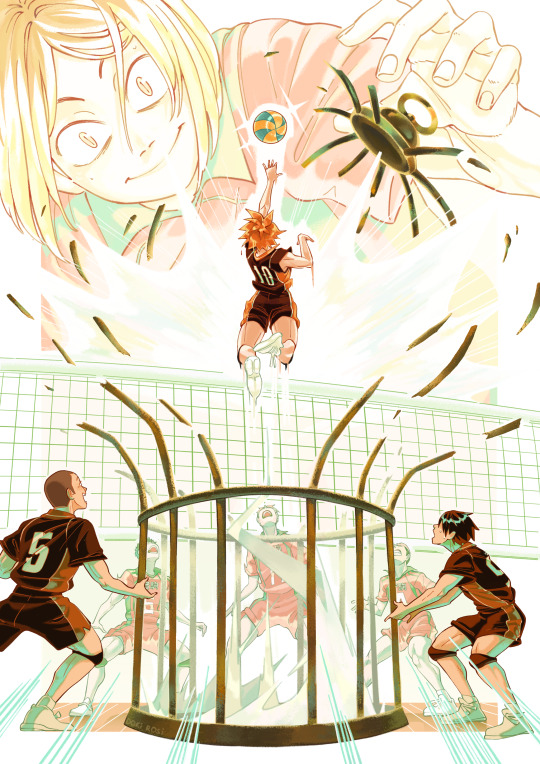
飛べ fly high!
Haikyu!! The Dumpster Battle
#◟ 𖠵 ˒ ⊹ ݁ ִdiosa’s diary entry#haikyuu!!#hq character analysis pending (indefinitely)…..#ill be thinking about the bird in the cage visual and kenma’s facial expressions for a while#and everyone looked sooo good !! especially kuroo and daichi 😵💫
12K notes
·
View notes
Text
are you cat pretty, fox pretty, deer pretty, bunny pretty, jellyfish pretty. are you gonna get rid of your hip dips or your strawberry legs or your baby cheeks. what’s your seasonal color, have you had a personal color analysis. what’s your kibbe body type. what’s your aesthetic, what kind of vibe are you tryna give. have you tried the butt pencil test. have you tried the charcoal face mask. what about the charcoal toothpaste. are you following the glass skin routine. have you tried sleeping with mouth tape on to get a better jawline. are you saving up for veneers or a BBL or a boob job. are you beer tanning this summer. have you optimized your shower routine. did you know that not making facial expressions keeps you from getting wrinkles. do you wanna learn how to be “That Girl.” do you wanna get the fox eye surgery or buccal fat removal. are you a girl boss or a bimbo. have you tried the hair identifier spray. are you gonna hide your double lip line. are you gonna get that liquid nose job. is your face card serving. does your pinky overlap your thumb when you wrap them around your wrist. how big is your nose gap. what’s your canthal tilt. did you know you can treat smile lines.
3K notes
·
View notes
Text
What Rafayel hid in Chapter 2 and what does it mean? Analysis & Theory
Someone pointed out in Reddit that Rafayel hid something from MC during chapter 2 when he was trying to look for his "collection log".
Spoilers for the Chapter 2, brief mention to chapter 8, Addictive Pain anecdote and some later mentions about Ebb and Flow and other memories.
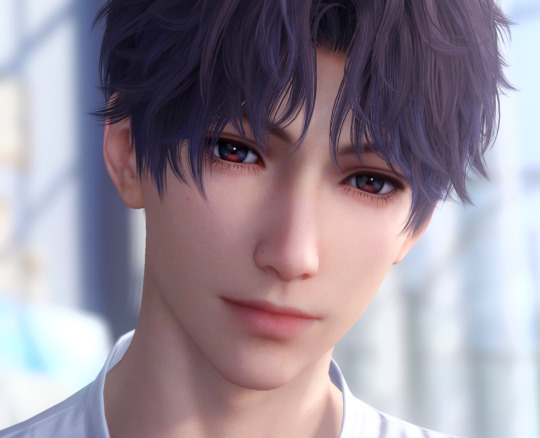
The original post in Reddit, thank you OP for pointing this out!
During chapter 2, MC investigates Rafayel's involvement in Raymond's behavior and deducts that his paints might have part in his erradic mental state. When Rafayel offers to show his collection log, he seems to notice something, hide it with his body bit more, glance at MC and show the log in his hands.
Why did he do that?
His body language screams "OH SHI-" when he notices the lime green note. It's just a note, and it's not like MC would be able to read it from where she is standing. I think it is a small hint towards how Rafayel has planned the entire meeting with MC beforehand - which in my mind, this chapter does allude to many times.
I already wrote a theory on their "first meeting" about how Rafayel didn't intend taking Reddie home. I didn't mention explicitly that I believe that he has planned all their meetings in the main story quite meticulously, aside a few details that don't go his way - for example with Reddie.
I think this note was supposed to make "the collection log" easily findable for Rafayel, so he can play along in his plan. He just didn't account for MC being so close, and possibly seeing the note herself, so he panicked to cover it up. Then he realised MC probably won't even notice the note, but tries to tuck it subtly out of view.
Did he really plan all this?
I really want to point out all the ways how Rafayel is manouvering MC along his plans during the main story so far, but I'll focus on this particular chapter for now. He is really good at manipulation - but in this chapter and many other moments, his facial expressions do reveal a lot. Unfrotunately Tumblr lets me post only one video per post, but if you go look the main story, you will be able to notice these things from these few chapters.
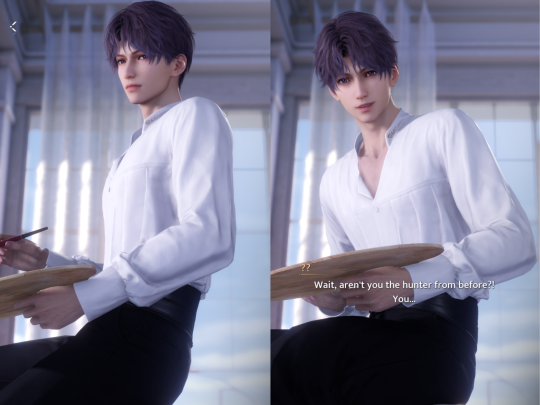
At first, he looks bit stern, like he is ready to tell someone off from barging in the studio without a call. After once he realises it's MC, he smiles quite widely considering someone came to his home uninvited. Not to mention that I don't believe a second him knocking the ladder was an accident...
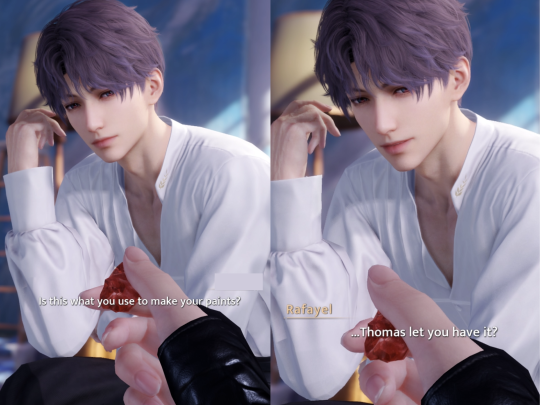
Rafayel looks surprisingly happy about the fact that Thomas let MC have the coral stones from his office. I don't know if Thomas is in with his plans or not, but for now for the sake of not going into another rabbit hole, I'll just say it's possible, but probably not.
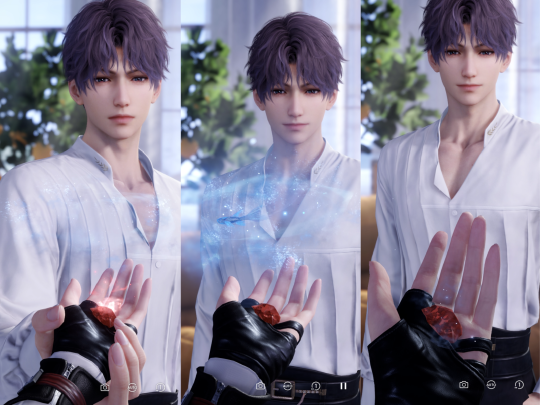
If you have read Addictive Pain anecdote, you know that Rafayel used his blood to experiment on paint pigments to get some kind of desired effect from them. The coral stones seem to be reacting to his blood, and he's smirking here because he's demonstrating to MC that he has valuable connections in this case. He already knew the effect his blood would have with the coral stone.
After the battle, before he makes the offer to MC to be his bodyguard, he smirks after MC agrees to listen what he has to say.

Something I want to point out too - notice the "collection log" he had? It's actually an invite to the nest. He doesn't have an actual collection log. Technically he is not lying when he said "I'll happily give you what I have in my hand right now" - he did give an invite to the nest for MC in chapter 8. He just showed it way before hand the actual Hunting Day took place.
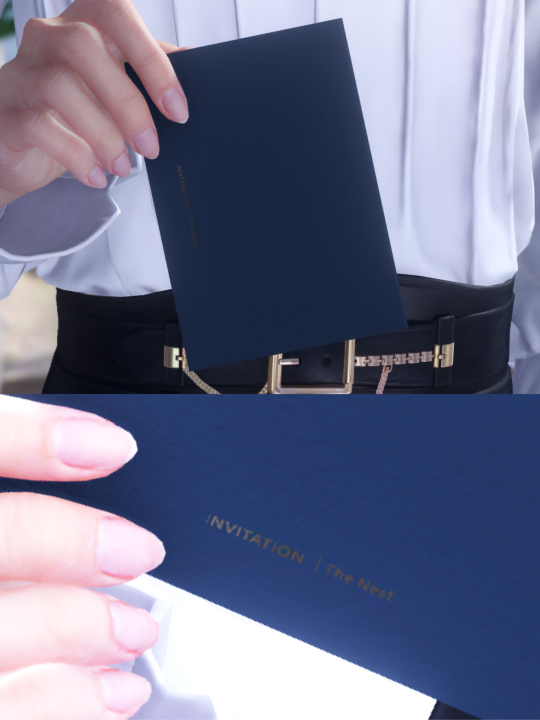
One last detail about how he managed to play MC like a fiddle during this chapter - he smirks in the end once he says "the door's over there". He's very pleased with himself. He managed to lead MC to believe that the only way to continue this investigation is to play along with his demands and become his bodyguard.
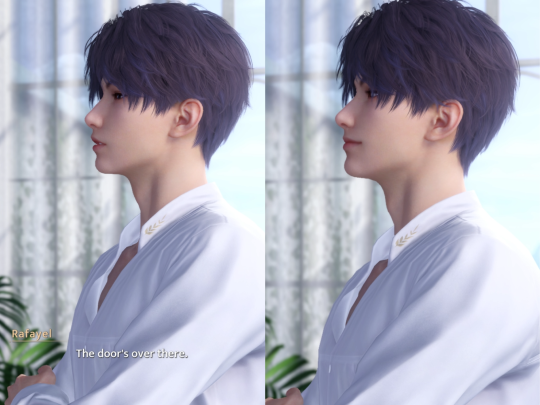
What a smug b....
... He is a siren, after all.
A lot of his memories and other moments highlight how masterfully he manages to make MC believe she is in control, but eventually he flips it completely around. During Ebb and Flow, after MC inspects his scales, it seems like she is in top of things with her little "You have to call me master" play - but then Rafayel turns it completely around, making her fall into his trap and takes control of the situation. In Gem affection, he lets MC to play around with him until he flips her over. This same theme repeats in several memories like Tipsy Invitation, Omnipotent Perception and Extreme Dose as well.
This exact story moment is probably the first moment we see this in action in a more convoluded way - he peaks her curiousity, controls the conversation and makes MC feel like she doesn't have any other option than play along with his game. It's also visible in the main story later, if I manage to make posts of the other chapters as well.
What if the note was something else?
Another thing that I'm thinking about is that it could be hint that the book the note is sticked to is some kind of marker for his notes about her from the times when he stalked her. I don't really have much to go on with that, but it's a possibility. All we can really deduct from how he reacted is that he probably didn't want MC to see whatever he was hiding.
On a more humorous note, it also could be the sketchbook every artist has and wants no one to see... Not that I have a such sketchbook or would know anything about that *cough cough*
560 notes
·
View notes